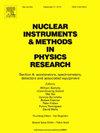n型低增益雪崩探测器辐照效应及空间电荷符号反转研究
IF 1.5
3区 物理与天体物理
Q3 INSTRUMENTS & INSTRUMENTATION
Nuclear Instruments & Methods in Physics Research Section A-accelerators Spectrometers Detectors and Associated Equipment
Pub Date : 2025-06-24
DOI:10.1016/j.nima.2025.170763
引用次数: 0
摘要
IMB-CNM开发了基于n型衬底(nLGADs)的低增益雪崩探测器,以增强对低穿透性粒子的检测,具有广泛的应用范围,从医学,工业到高能物理(HEP)的协同发展。在CERN PS-IRRAD装置上,通过质子辐照研究了nLGADs的辐照效应,质子辐照的影响达到1 × 1014 cm−2。辐照前后的电学表征揭示了n型体的空间电荷符号反转,导致损耗行为和电场分布发生了显著变化。利用UV TCT和TPA-TCT测量,更详细地研究了辐照对电场和增益的影响,证实了传感器损耗的变化和增益层电场的减小。结果表明,与传统p型lgad的受体去除相比,nlgad的供体去除更明显,但影响更小。这些发现不仅提供了辐照对nlgad影响的初步见解,而且有助于开发量化供体切除的方法。本文章由计算机程序翻译,如有差异,请以英文原文为准。
Investigating irradiation effects and space charge sign inversion in n-type Low Gain Avalanche Detectors
Low Gain Avalanche Detectors built on n-type substrate (nLGADs) have been developed by IMB-CNM to enhance the detection of low-penetrating particles, with a wide range of applications from medicine, industry to synergies with developments for high-energy physics (HEP). In this work, irradiation effects on nLGADs were investigated through proton irradiation at the CERN PS-IRRAD facility up to proton fluences of 1 1014 cm−2. Electrical characterization before and after irradiation reveals space charge sign inversion of the n-type bulk, leading to significant modifications in the depletion behavior and electric field distribution. Utilizing UV TCT and TPA-TCT measurements, the impact of irradiation on the electric fields and the gain are studied in more detail, confirming a change of sensor depletion and a reduced electric field in the gain layer. The results suggest that donor removal in nLGADs is stronger pronounced already at lower fluences compared to acceptor removal in traditional p-type LGADs. These findings provide not only first insights into the effects of irradiation on nLGADs but also contribute to the development of methods to quantify the donor removal.
求助全文
通过发布文献求助,成功后即可免费获取论文全文。
去求助
来源期刊
CiteScore
3.20
自引率
21.40%
发文量
787
审稿时长
1 months
期刊介绍:
Section A of Nuclear Instruments and Methods in Physics Research publishes papers on design, manufacturing and performance of scientific instruments with an emphasis on large scale facilities. This includes the development of particle accelerators, ion sources, beam transport systems and target arrangements as well as the use of secondary phenomena such as synchrotron radiation and free electron lasers. It also includes all types of instrumentation for the detection and spectrometry of radiations from high energy processes and nuclear decays, as well as instrumentation for experiments at nuclear reactors. Specialized electronics for nuclear and other types of spectrometry as well as computerization of measurements and control systems in this area also find their place in the A section.
Theoretical as well as experimental papers are accepted.

 求助内容:
求助内容: 应助结果提醒方式:
应助结果提醒方式:


